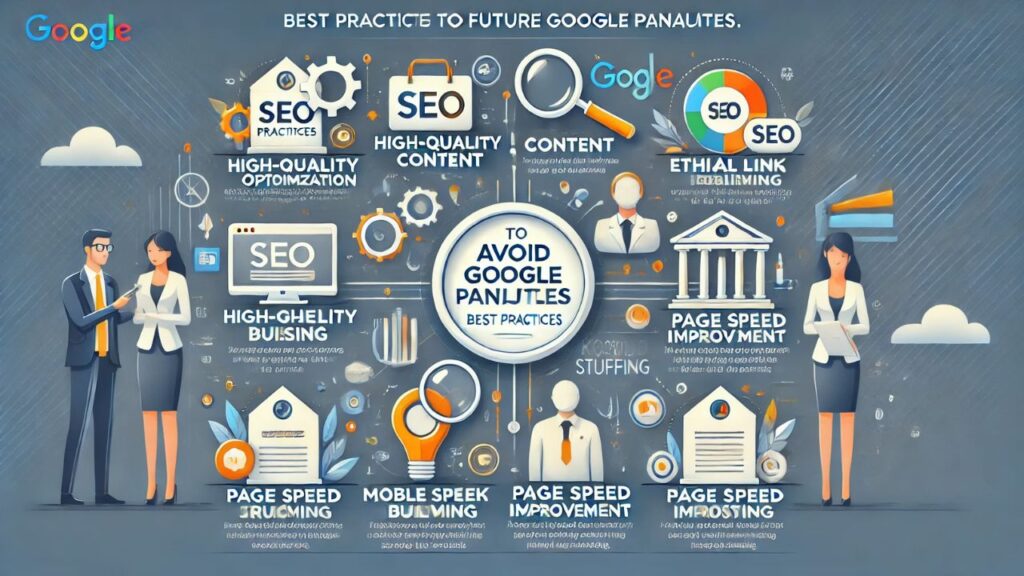Search engine optimization (SEO) is crucial for maintaining online visibility, but even well-optimized websites can face setbacks due to Google penalties. These penalties can significantly reduce search rankings and organic traffic, impacting business growth. Understanding how to recover from Google penalties efficiently is essential for website owners, marketers, and SEO professionals.
This guide explores the role of SEO recovery specialists, the types of Google penalties, and the best practices for quick recovery.
Table of Contents
Understanding Google Penalties
Google imposes penalties when a website violates its Webmaster Guidelines. These penalties can be manual actions or algorithmic adjustments, both of which can lead to a decline in search visibility.
Manual Penalties
Manual penalties occur when Google’s spam review team flags a website for violations. Site owners are notified via Google Search Console with details about the issue. Common reasons include:
- Unnatural backlinks (purchased links, excessive link exchanges)
- Thin or duplicate content
- Keyword stuffing
- Cloaking and deceptive redirects
- User-generated spam
- Hidden text or links
Manual penalties require direct intervention to resolve the identified issues before submitting a reconsideration request to Google.
Algorithmic Penalties
Algorithmic penalties result from Google’s automated systems identifying violations. Unlike manual penalties, these do not generate direct notifications in Search Console. Common algorithms responsible for penalties include:
- Google Panda (content quality issues)
- Google Penguin (link profile concerns)
- Google Hummingbird (keyword stuffing and irrelevant content)
- Google Core Updates (broad ranking adjustments based on user intent and content quality)
Algorithmic penalties require strategic adjustments to content, backlinks, and overall site structure to regain rankings.
The Role of SEO Recovery Specialists
SEO recovery specialists specialize in efficiently identifying, diagnosing, and resolving Google penalties. Their expertise lies in conducting thorough audits, addressing technical issues, and ensuring compliance with Google’s evolving guidelines.
Key Responsibilities of SEO recovery specialists
- Penalty Identification – Determining whether the issue is manual or algorithmic.
- Backlink Analysis – Evaluating link profiles to remove or disavow harmful links.
- Content Optimization – Ensuring high-quality, original content with proper keyword usage.
- Technical SEO Fixes – Addressing issues like mobile-friendliness, site speed, and structured data errors.
- Google Reconsideration Requests – Submitting appeals for manual penalties with a well-documented recovery strategy.
- Monitoring and Maintenance – Continuously tracking site performance and maintaining compliance.
By following a structured approach, SEO recovery specialists help websites regain lost traffic and rankings.
Steps to Recover from Google Penalties Quickly
Resolving Google penalties requires a systematic process. Below are the essential steps to achieve recovery efficiently.
Conduct a Comprehensive SEO Audit
The first step in penalty recovery is performing a detailed audit to diagnose issues. SEO recovery specialists use tools like Google Search Console, Google Analytics, Ahrefs, SEMrush, and Screaming Frog to gather insights.
Audit Focus Areas:
- Search Visibility Loss: Identifying when rankings dropped to determine correlation with algorithm updates.
- Google Search Console Alerts: Checking for manual penalties or security warnings.
- Backlink Profile: Reviewing unnatural or toxic backlinks.
- Content Quality: Assessing duplicate, thin, or over-optimized content.
- Technical SEO Issues: Fixing crawl errors, mobile usability problems, and slow-loading pages.
Once the audit is complete, the next step is addressing the identified issues.
Fix Unnatural Backlinks
A backlink cleanup is necessary if a penalty results from a poor backlink profile.
Actions to Take:
- Identify Toxic Links: Use backlink analysis tools to detect spammy or low-quality links.
- Contact Webmasters: Request removal of harmful backlinks.
- Disavow Links: Use Google’s Disavow Tool to inform Google to ignore problematic links.
Maintaining a natural and diverse backlink profile is essential for long-term SEO success.
Improve Content Quality
If content-related issues triggered the penalty, refining website content is crucial.
Best Practices for Content Optimization:
- Eliminate Duplicate Content: Rewrite or consolidate similar pages to avoid redundancy.
- Enhance Readability: Structure content with headings, bullet points, and concise paragraphs.
- Optimize Keywords Naturally: Avoid excessive keyword repetition while ensuring relevance.
- Provide Value: Focus on user intent and address audience needs effectively.
Quality content not only helps in penalty recovery but also strengthens long-term rankings.
Address Technical SEO Issues
Technical SEO plays a significant role in search engine rankings. Resolving technical issues improves crawlability and user experience.
Key Technical Fixes:
- Improve Page Speed: Optimize images, enable browser caching, and use content delivery networks (CDNs).
- Ensure Mobile-Friendliness: Use responsive design and test with Google’s Mobile-Friendly Tool.
- Fix Broken Links and Redirects: Ensure all internal and external links function correctly.
- Optimize Site Structure: Implement proper URL hierarchy, breadcrumbs, and schema markup.
A technically sound website ensures smooth crawling and indexing by Google.
Submit a Reconsideration Request (For Manual Penalties)
Once corrective actions are taken, submitting a reconsideration request through Google Search Console is necessary for manual penalties.
How to Submit a Request:
- Explain the Issue: Provide details about the penalty and the steps taken to resolve it.
- Demonstrate Compliance: Show that the site now adheres to Google’s guidelines.
- Provide Supporting Evidence: Include screenshots, links, and documentation of corrections made.
Reconsideration requests typically take several weeks for Google to review. Maintaining transparency increases the chances of a successful appeal.
Monitor Recovery Progress
Post-recovery, continuous monitoring ensures the site remains compliant and regains rankings.
Monitoring Strategies:
- Track Search Console Reports: Check for any new warnings or indexing issues.
- Analyze Traffic Patterns: Use Google Analytics to observe traffic recovery trends.
- Monitor Keyword Rankings: Track improvements in keyword positions.
- Regular Backlink Audits: Ensure the site does not accumulate harmful links again.
Ongoing SEO maintenance prevents future penalties and enhances website stability.
Best Practices to Avoid Future Google Penalties

Preventing penalties is more efficient than recovering from them. Implementing best practices ensures long-term search engine stability.
Follow Google’s Webmaster Guidelines
Stay updated with Google’s policies and algorithm updates to maintain compliance.
Build High-Quality Backlinks Naturally
Focus on organic link-building strategies, such as guest blogging, industry partnerships, and authoritative content creation.
Maintain High-Quality Content
Ensure all content is original, informative, and user-focused. Regularly update old content to keep it relevant.
Optimize for User Experience (UX)
Enhance website navigation, page load speed, and mobile responsiveness to improve user engagement.
Use Ethical SEO Practices
Avoid black-hat techniques such as keyword stuffing, cloaking, and excessive link schemes. Ethical SEO ensures sustainable growth.
Conclusion
Recovering from Google penalties requires a strategic and methodical approach. SEO recovery specialists play a crucial role in diagnosing issues, implementing corrective actions, and ensuring long-term compliance with Google’s guidelines. By conducting thorough audits, improving content quality, addressing technical SEO concerns, and monitoring performance, websites can regain lost rankings and sustain organic traffic.
Prevention is always better than recovery. By following best SEO practices, businesses can maintain search engine visibility and avoid future penalties. Regular updates, ethical SEO strategies, and adherence to Google’s guidelines contribute to a strong and resilient online presence.
FAQ
What is a Google penalty in SEO?
A Google penalty is a ranking drop or deindexing caused by violating Google’s Webmaster Guidelines, either through a manual action or algorithmic update.
How do I know if my website has a Google penalty?
Check Google Search Console for manual action notifications or analyze traffic drops using Google Analytics to identify possible algorithmic penalties.
What are the common reasons for Google penalties?
Penalties often occur due to unnatural backlinks, duplicate content, keyword stuffing, hidden text, cloaking, or spammy practices.
How long does it take to recover from a Google penalty?
Recovery time varies, but manual penalties can take weeks after submitting a reconsideration request, while algorithmic penalties depend on updates and fixes.
Can I remove a Google penalty myself?
Yes, but it requires identifying the issue, fixing violations, and submitting a reconsideration request (for manual penalties) or improving SEO practices (for algorithmic penalties).
What is a reconsideration request in Google Search Console?
A reconsideration request is an appeal submitted to Google after fixing a manual penalty, requesting a review to restore search rankings.
How do SEO recovery specialists help with penalties?
They conduct audits, identify issues, remove toxic backlinks, improve content, fix technical SEO problems, and guide penalty recovery strategies.
Can I prevent future Google penalties?
Yes, by following Google’s Webmaster Guidelines, using ethical SEO practices, creating high-quality content, and maintaining a natural backlink profile.
Are all ranking drops caused by Google penalties?
No, rankings can decline due to algorithm updates, competition, technical issues, or content changes, not necessarily a penalty.
Does disavowing backlinks help recover from a penalty?
Yes, if harmful backlinks caused the penalty, using Google’s Disavow Tool can help remove their negative impact on rankings.



